|
Extreme Dilute Photo Gallery
(All photos are of hamsters from the River Road Hamstery.)
| These are the first two hamsters bred that are free of the three major contaminant genes (Banded, Umbrous and Dark Eared White) plaguing the development of the Extreme Dilutes.
Still, they carry recessive color genes, including Black which could certainly be increasing the ticking and the blackness of the cheekflashes and dulling the color quality. |
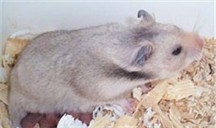
Shorthair Extreme Dilute female
(cece) |
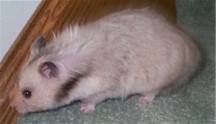
Longhair Extreme Dilute female
(cece) |
| Next are two variations that affect the color. The heterozygous female on the left is lighter by virtue of her DEW gene, but she is also Satin which adds a shine that can seem
to alter the color. On the right, the longhair coat of the male makes his color appear lighter. All Extreme Dilutes are grey with subtle cream tones. In photos, they can range from
a silver grey to almost light brown, depending on background and lighting conditions. |
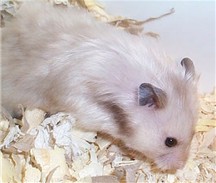
Longhair Satin Heterozygous Extreme Dilute female
(cecd) |
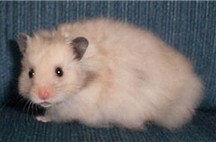
Longhair Extreme Dilute male
(cecd) |
| Umbrous presented considerable confusion as the line was developed. It was not known if the darker hamsters were homozygous, if they were of a different variety of the gene or
if they were Umbrous. They turned out to be Umbrous which is best seen as shading on the crescents though this can be quite difficult to discern. The grouchy Umbrous female on the left
was the first homozygous Extreme Dilute. On the right are a pair of 16 day old pups, both ED, one Umbrous. The sooty overlay and grey crescents and belly are most obvious at this early
stage. |
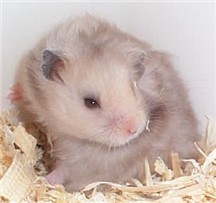 |
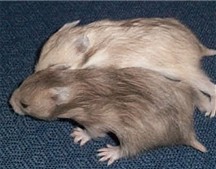 |
| The effect of ED on Black is to change it to a dark chocolate brown. The absolute amount of pigment is probably also diminished. In the heterozygous state this is much more pronounced,
producing a café au lait color. At right, shown together, are three young siblings — Heterozygous ED Black, ED Black and Black. The older ED Black (below right) is not quite
as dark as she looks here and differs from a "browning" Black with hindquarter fading in that her coloring is rich and uniform. |
|
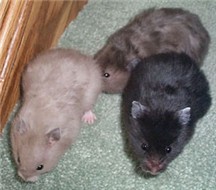 |
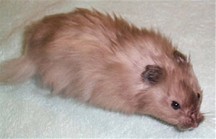
Heterozygous Extreme Dilute Black male
(aacecd) |
|
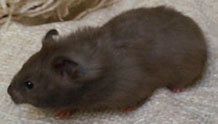
Extreme Dilute female
(aacece) |
| The two young hamsters below have not developed all their coloring yet. The one on the left looks exactly like a Flesh Eared White. The slight cinnamon on her nose can be seen
at an older age. The dirty cream color of the ED Cinnamon became even duller with age. |
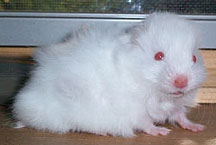 |
|
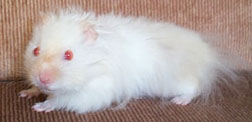 |
| Banded Heterozygous Extreme Dilute Cinnamon (Ba_cecdpp) |
|
Banded Extreme Dilute Cinnamon (Ba_cecepp) |
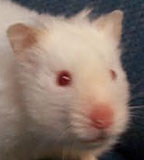 |
|
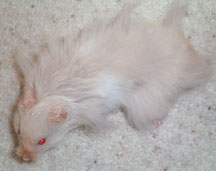 |
| Two more changes with age can be seen in these next two young hamsters. Although they are different colors, both darken with more cream/brown shading. |
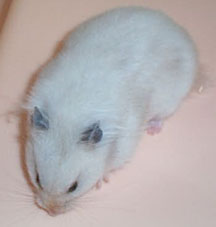 |
|
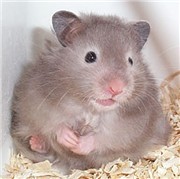 |
| Heterozygous Extreme Dilute (cecd) |
|
Extreme Dilute Sable (ceceeeU_) |
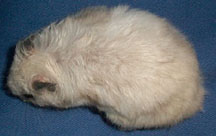 |
|
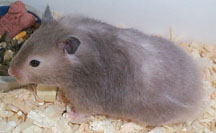 |
| These two Black Eyed Whites arose in a litter from a Golden Tort and a Yellow male. They will be bred to prove their genotype, but are presumed from their phenotype and the parents' pedigrees to be Heterozygous ED Yellow. Heterozygous ED Black Eyed Cream should look the same. With age they may develop tinting on the nose and hindquarters. |
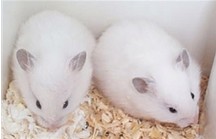 |
Top
|



















